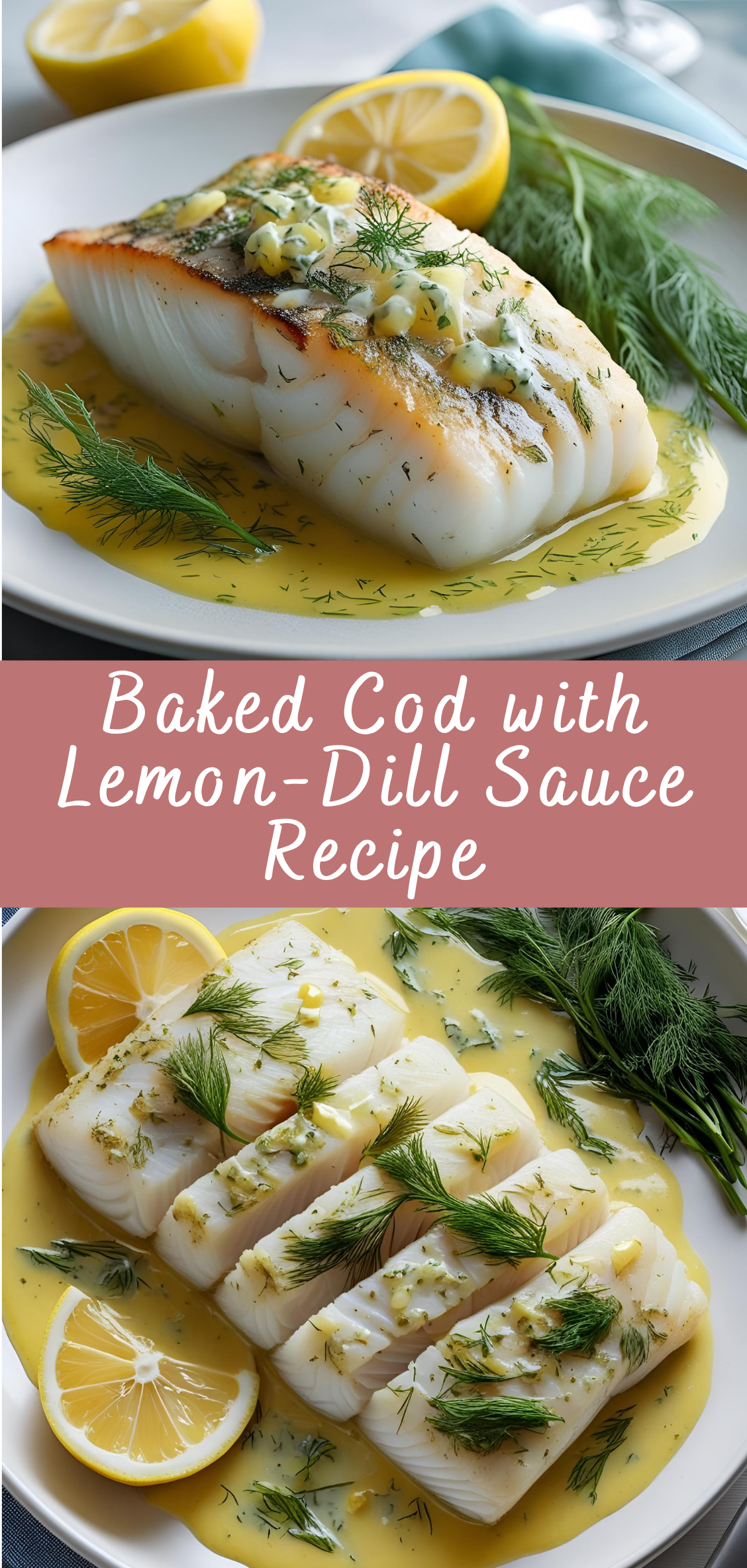Baked Cod with Lemon-Dill Sauce Recipe
Few dishes manage to balance simplicity, elegance, and nutritional value quite like baked cod with lemon-dill sauce. This classic preparation is a perfect example of how minimal ingredients, when thoughtfully combined, can produce flavors that are both subtle and deeply satisfying. Light, flaky cod—mild in flavor yet rich in protein—meets a bright, herbaceous sauce made from fresh dill, zesty lemon, and just the right touch of cream or butter to tie everything together. The result is a dish that feels clean and refined, making it just as suitable for a casual weeknight meal as it is for entertaining guests.

Cod has long been a staple in global cuisine, appreciated for its tender texture, lean profile, and versatility. Its neutral taste makes it the ideal canvas for a variety of flavor profiles, but when paired with lemon and dill, it takes on a particularly refreshing and coastal character. These ingredients, commonly found in Northern and Eastern European kitchens, complement the fish without overpowering it—elevating its natural sweetness and clean ocean flavor.
The lemon-dill combination is a timeless one. Lemon brings brightness and acidity, which cuts through the richness of any accompanying fat—whether it’s butter, olive oil, or a light cream base—while dill introduces an aromatic, almost grassy freshness that lingers on the palate. When used together, these ingredients create a sauce that’s at once light and luxurious, classic yet never boring.
What sets this dish apart is not just its flavor, but its balance. In a world where rich, over-complicated sauces often steal the spotlight, baked cod with lemon-dill sauce stands as a reminder that restraint in cooking can yield the most rewarding results. It speaks to a culinary philosophy that values clarity of flavor, ingredient quality, and clean cooking methods.
This guide goes far beyond a simple recipe. It aims to equip you with a deep understanding of each element—why cod behaves the way it does in the oven, how to build a sauce that complements rather than competes, and how to adapt this dish to suit different dietary needs or flavor preferences. You’ll learn about the various types of cod available, optimal baking techniques, and common mistakes to avoid, ensuring perfect results every time.
You’ll also discover the cultural roots of this dish, as lemon-dill sauces appear across various cuisines—from Scandinavian gravlax accompaniments to Mediterranean fish dishes. Understanding these influences adds not just flavor to your plate but context to your culinary journey.
Whether you’re new to cooking fish or you’re looking to perfect a go-to favorite, this comprehensive recipe will give you the confidence and skill to make baked cod with lemon-dill sauce a reliable part of your repertoire. By the end, you’ll not only know how to prepare it—you’ll understand how to make it your own.
Step-by-Step Instructions: Baked Cod with Lemon-Dill Sauce
Step 1: Prepare and Organize Your Ingredients
Begin with mise en place—a French culinary term that means “everything in its place.” Having all your ingredients measured and ready helps streamline the cooking process and reduces stress in the kitchen.
For the Baked Cod:
-
4 cod fillets (5–6 oz each), skinless and boneless
-
2 tablespoons olive oil or melted butter
-
1 teaspoon sea salt
-
½ teaspoon freshly ground black pepper
-
1 teaspoon garlic powder (optional for extra depth)
-
Lemon zest from 1 lemon
-
Juice from 1 lemon (approximately 2–3 tablespoons)
-
Fresh parsley or dill, for garnish (optional)
For the Lemon-Dill Sauce:
-
2 tablespoons unsalted butter or olive oil
-
2 garlic cloves, finely minced
-
1 cup fish stock, chicken stock, or dry white wine (use what you have)
-
1 tablespoon lemon zest
-
2 tablespoons freshly squeezed lemon juice
-
½ cup heavy cream or Greek yogurt (for a lighter option)
-
1 tablespoon Dijon mustard (optional, adds a tangy complexity)
-
3 tablespoons chopped fresh dill
-
Salt and pepper, to taste
Note: Fresh dill is strongly recommended for the sauce, but dried dill can be used in a pinch. If using dried, reduce to 1 tablespoon.
Step 2: Preheat the Oven
Set your oven to 400°F (200°C). A moderate to high temperature is ideal for baking cod—it cooks quickly and evenly, developing a slightly golden exterior while remaining moist inside.
If you’re using a convection oven, you may lower the temperature slightly (to around 375°F/190°C) to account for faster heat circulation.
Step 3: Prepare the Cod Fillets
-
Pat the cod dry using paper towels. This is essential for proper seasoning and even baking. Removing excess moisture helps prevent steaming and promotes better texture.
-
Season the cod on both sides with sea salt, black pepper, and optional garlic powder. Sprinkle with lemon zest for a touch of citrus brightness.
-
Drizzle or brush olive oil or melted butter over each fillet to lock in moisture and encourage gentle browning during baking.
-
Optional Step: If you prefer a more aromatic finish, line the baking dish or sheet with a few lemon slices and a few sprigs of dill or parsley. Place the fillets directly on top.
Step 4: Bake the Cod
-
Line a baking dish or rimmed sheet pan with parchment paper or lightly oil it to prevent sticking.
-
Arrange the seasoned cod fillets evenly in the dish. Ensure they are not touching—this promotes even cooking.
-
Place the dish in the preheated oven and bake for 12 to 15 minutes, depending on the thickness of the fillets.
-
Check for doneness:
-
The cod should flake easily with a fork.
-
The internal temperature should reach 145°F (63°C) at the thickest point.
-
The flesh should turn opaque and go from translucent to white.
-
Tip: Avoid overcooking. Cod is a lean fish and dries out easily if left in the oven too long.
Step 5: Make the Lemon-Dill Sauce (While the Cod Bakes)
Timing is key here—start the sauce while the cod is baking to serve everything hot and fresh.
-
In a small saucepan over medium heat, melt the butter or warm the olive oil.
-
Add the minced garlic and sauté for about 30 seconds to 1 minute, just until fragrant. Do not let it brown—it should remain golden and soft.
-
Pour in the stock or wine and bring to a gentle simmer. Let it reduce by about one-third. This concentrates the flavor and creates the foundation for your sauce.
-
Stir in the lemon juice, lemon zest, and Dijon mustard (if using). Whisk until well combined.
-
Lower the heat and gently stir in the cream or Greek yogurt. Let the sauce warm and thicken slightly, stirring constantly. Do not let it boil, especially if using yogurt—it could curdle.
-
Add the chopped fresh dill and season with salt and pepper to taste. Let the sauce rest for 2–3 minutes off the heat to allow the flavors to meld.
Step 6: Plate the Cod
-
Use a fish spatula or wide flat utensil to carefully lift each cod fillet from the baking dish.
-
Plate each fillet on individual dishes or a serving platter. Spoon a generous amount of lemon-dill sauce over the top.
-
Garnish with fresh dill sprigs, lemon wedges, or a sprinkle of chopped parsley for a fresh, vibrant finish.
Step 7: Serve Immediately
Baked cod is best served hot, directly from the oven. Pair it with any of the following to create a well-rounded meal:
-
Steamed asparagus or green beans
-
Garlic mashed potatoes or roasted baby potatoes
-
Brown rice or lemon-herb quinoa
-
A light green salad with vinaigrette
-
Crusty bread to mop up extra sauce
Optional Variations and Tips
Flavor Variations:
-
Add a pinch of red pepper flakes to the sauce for mild heat.
-
Use fresh tarragon or chives in place of dill for a different herb profile.
-
Include a few capers or finely chopped shallots in the sauce for a briny, complex touch.
Dairy-Free Option:
-
Substitute butter with olive oil and cream with full-fat coconut milk or cashew cream. The flavor will change slightly, but it will still be rich and satisfying.
Fish Substitutions:
-
If cod isn’t available, try haddock, pollock, halibut, or even tilapia. Just adjust cooking time based on thickness.
Make-Ahead Tip:
-
The sauce can be made up to a day in advance and gently reheated. Be sure to warm it over low heat to avoid separation.
Baked Cod with Lemon-Dill Sauce Recipe
Few dishes manage to balance simplicity, elegance, and nutritional value quite like baked cod with lemon-dill sauce. This classic preparation is a perfect example of how minimal ingredients, when thoughtfully combined, can produce flavors that are both subtle and deeply satisfying. Light, flaky cod—mild in flavor yet rich in protein—meets a bright, herbaceous sauce made from fresh dill, zesty lemon, and just the right touch of cream or butter to tie everything together. The result is a dish that feels clean and refined, making it just as suitable for a casual weeknight meal as it is for entertaining guests.
Ingredients
- For the Cod:
- 4 cod fillets (5–6 oz each)
- 1 tbsp olive oil or melted butter
- Salt and pepper, to taste
- 1 lemon, thinly sliced
- Optional: paprika or garlic powder for light seasoning
- For the Lemon-Dill Sauce:
- 1/2 cup sour cream or Greek yogurt
- 2 tbsp mayonnaise (optional for richness)
- 1 tbsp fresh lemon juice (about 1/2 lemon)
- 1 tsp lemon zest
- 1 tbsp fresh dill, chopped (or 1 tsp dried)
- 1 small garlic clove, minced
- Salt and pepper, to taste
Instructions
- Preheat Oven:
Preheat your oven to 400°F (200°C). Line a baking sheet with parchment paper or lightly grease a baking dish. - Prepare Cod Fillets:
Pat the cod fillets dry with paper towels. Place them on the baking sheet. Drizzle with olive oil or melted butter, and season with salt, pepper, and a little paprika or garlic powder if desired. - Add Lemon Slices:
Lay 1–2 thin lemon slices over each fillet. - Bake:
Bake for 12–15 minutes, or until the fish is opaque and flakes easily with a fork. Thicker fillets may take up to 18 minutes. - Make the Lemon-Dill Sauce:
While the cod bakes, whisk together the sour cream (or yogurt), mayonnaise (if using), lemon juice, lemon zest, dill, and garlic. Season with salt and pepper to taste. Chill until ready to serve. - Serve:
Plate the baked cod and spoon the lemon-dill sauce over the top or serve it on the side. Garnish with fresh dill or a lemon wedge if desired.
Notes
- Fish Alternatives: This recipe works well with haddock, halibut, or tilapia.
- Low-Fat Option: Use plain nonfat Greek yogurt and skip the mayo for a healthier sauce.
- Pairing Ideas: Serve with roasted vegetables, steamed asparagus, wild rice, or a simple quinoa salad.



